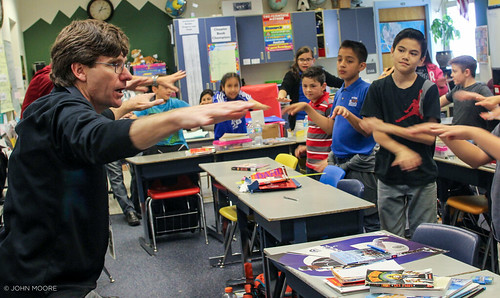DCPA NEWS CENTER
Enjoy the best stories and perspectives from the theatre world today.
Enjoy the best stories and perspectives from the theatre world today.
Video by DCPA Video Producer David Lenk.
DCPA Education is well-known for what is called “Dramatic Learning” – workshops that incorporate performative elements into classroom exercises to stimulate comprehension and retention.
But its newest partnership with Noble Energy is perhaps its most unlikely collaboration yet.
 Reservoir Engineer Paul Majors is a scientist whose job is to find oil and gas reserves 7,000 feet below the surface of the Earth. DCPA Teaching Artist David Saphier is more used to teaching young people Shakespeare and introductory acting techniques. But working together, this odd and affable couple crafted an interactive pilot program to help 5th graders better understand oil, energy and the earth sciences.
Reservoir Engineer Paul Majors is a scientist whose job is to find oil and gas reserves 7,000 feet below the surface of the Earth. DCPA Teaching Artist David Saphier is more used to teaching young people Shakespeare and introductory acting techniques. But working together, this odd and affable couple crafted an interactive pilot program to help 5th graders better understand oil, energy and the earth sciences.
Denver’s Barnum Elementary School is one of 10 Denver schools the pair visited this semester. “The goal is to teach these students where energy comes from and why we need it,” said Majors, who has been visiting classrooms on behalf of Noble Energy for 12 years.
Their lesson plan: What is energy? Where is it found? How did it get there? How do we get it out? Then, of course: Why do we need it, and what do we do with it? Saphier said the program follows the Colorado Department of Education’s academic standards for science.
“Everything we do takes some form of energy,” said Majors, who brought in jarred oil and core samples to show “that oil is a lot like people,” he said. “It comes in all different colors, shapes and sizes.”
Saphier’s teaching style is learning by doing. “I like to get the kids out of their desks, moving around, creating something and learning in a different way,” he said. “What’s unique about this is that I have an actual expert in the here with me. That’s rare.”
The kids learned about the different types of power including wind, hydropower, solar and gas. They learned that anything made of plastic is made of oil. Saphier had the students turning themselves into soccer balls, refrigerators and video-game consoles. Soon, he had them demonstrating how, over millions of years, a wilting tree is buried and turns into an energy deposit.

DCPA Education’s David Saphier leads Branum Elementary School 5th-graders in an interactive exercise. Photo by John Moore for the DCPA NewsCenter.
Afterward, the students had the opportunity to ask questions, which revealed interesting facts such as: The subterranean oil field that stretches from Weld County in Northern Colorado to Wyoming is the ninth-largest oil and gas field in the nation.
“I’m trying to get kids educated about oil and gas and how it’s a bigger part of the entire energy cycle,” said Majors. “This program with DCPA Education is an effective way to get the information across – and it’s a lot of fun. The kids retain the information. They are engaged. Everyone is on board.
“You can’t be daydreaming when you are pretending you are a tree.”

GLOSSARY:
Renewable energy sources: Energy that is collected from resources which are naturally replenished on a human timescale, such as sunlight, wind, rain, tides, waves, and geothermal heat.
Non–renewable energy sources: Most are fossil fuels: coal, petroleum and natural gas. Carbon is the main element in fossil fuels.
Fossil fuel: A natural fuel such as coal or gas, formed in the geological past from the remains of living organisms.
Our photo gallery from the energy workshop:
 Photos from our visit to Barnum Elementary. To see more, just push the forward arrow on the image above. Photos by John Moore for the DCPA NewsCenter.
Photos from our visit to Barnum Elementary. To see more, just push the forward arrow on the image above. Photos by John Moore for the DCPA NewsCenter.

Leave a Reply
Want to join the discussion?Feel free to contribute!